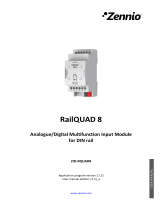External Reference Temperature Object [disabled/enabled]: enables the
“[AC] External Reference Temperature” 2-Byte object, which provides the
value of an external temperature sensor, which is used by the AC machine as
the reference to execute the control loop.
If during 3 minutes, no temperature values are received, values of the internal
probe will be recuperated again to execute temperature control, in the same
way as it will be controlled if KLIC-SG was configured disabling this option. If
a new external temperature value is received, the control will be executed
again by using this external value. The range of values allowed for this object
is [0-70] ºC, if different values are received, they will be ignored.
TEMPERATURE SETPOINT
The following objects to control and supervise setpoint temperature will be available by
default:
“[AC] Temperature Setpoint”: 2-Byte object to select decimal temperature
values that belong to the range [16º-30º].
“[AC] Temperature Setpoint (Status)”: 2-Byte object that provides the
temperature setpoint status.
Note: A X.Y value will be rounded to X.0 if [Y < 5] or to X.5 if [Y ≥ 5].
Status object will be updated to the last setpoint temperature value received by the A/C
unit after a complete communication cycle and will be sent to KNX bus every time that
its value changes.
Last setpoint temperature that was set in either mode, will be stored and sent to the
machine each time the operation mode is changed. Thus, a change in the setpoint
temperature is done exclusively for the current operation mode of the machine.
Setpoint limits can be configured by parameter:
Setpoint Limits [disabled/enabled]: allows restricting the range of the
temperature setpoint (from below in the Cooling and Auto modes and from
above in the Heating and Auto modes), provided that the limits are still within
the predefined limits of the A/C unit. When KLIC-SG receives an order to send



































